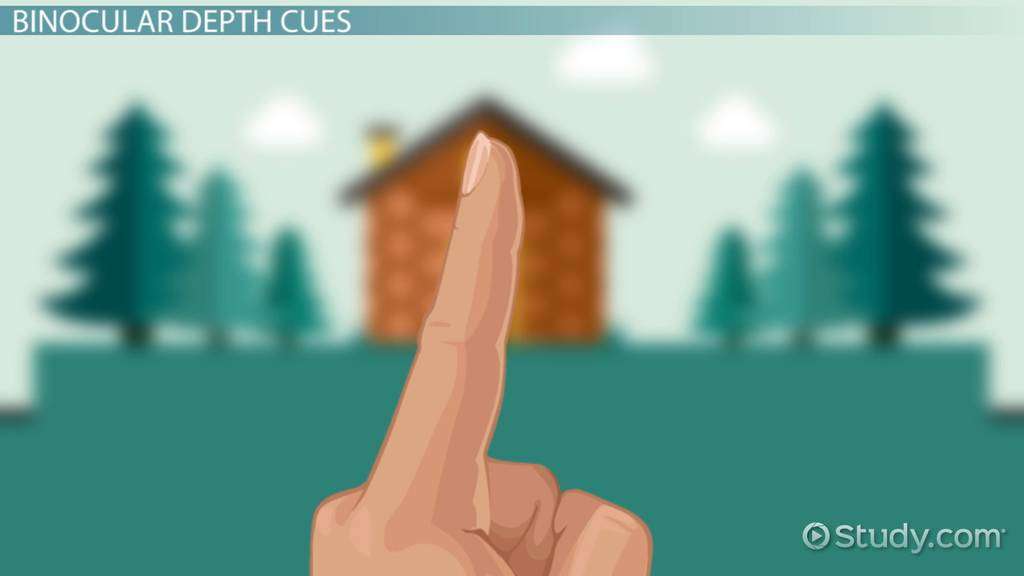How is Depth Perception Created?
Depth perception is created when the eyes and the brain work together in an effort to perceive the depth, or the length, width, and height, of the world around us. Humans have two eyes. Having two eyes to see through is called binocular vision. Binocular vision helps to create a stronger sense of depth perception than monocular vision or having one eye. This is because the brain can get a view from two different angles, thus seeing the same object or room from a slightly different length, width, and height, through both eyes. When the images are compiled within the brain and one image is produced for us to comprehend or ‘see’ then we can perceive depth. When looking at a small object, humans have the ability to turn both of their eyes in slightly. This effect is called convergence and it allows for a closer look at small objects, which allows the brain to better perceive the length, width, and height of the object within space. Depth perception examples include:
- Knowing how close someone is when they are walking toward us.
- Having a pencil and a mug on the desk and being able to tell which one is closer.
- Seeing a dog running away and knowing how far away it is.
Seeing a dog running and knowing how close it is.

Binocular and Monocular Depth Cues
There are a variety of visual cues to help a person determine the depth of the world around them and have special awareness both in the monocular and binocular sense. Binocular depth cues are all of the ways that both eyes can help to perceive the world around us. Monocular depth cues are all the ways that just one eye can see the world around us and help us to perceive it. There are a few important terms to know when discussing depth cues.
Binocular depth cues include:
- Retinal disparity which is the slightly different images a person’s two eyes send to the brain.
- Fusion is where the brain combines two different images to make it into one.
Monocular depth cues include:
- Shadow stereopsis refers to the perceptions of areas that are in the shadows and how they are perceived by people with normal binocular vision. These areas are perceived differently by the eyes because they do not have defined outlines, but instead have gradients.
- Relative size of an object refers to the size that the object looks. Objects that are farther away look smaller to the eye, while objects that are closer up look larger.
- Texture gradient is an example of linear perspective. Objects that are farther away or extend farter away from us such as a cornfield will appear to have a finer, smoother texture the farther out it is. The texture will be more defined with close-up objects.
- Interposition is the perception that one object is covering another object because it is in front of it. It is a position cue.
- Motion parallax refers to objects that appear to move faster if they are closer to a person, and objects appearing to move slower if they are farther away from a person. This is due to the perceived distance that the object is traveling.
Evolution of Depth Perception
Humans have good depth perception because their eyes are close together and face in front of them. This allows the vision that they see through binocular eyes to overlap. When the vision overlaps it improves the brain’s ability to perceive depth.
Many animals such as chickens, fish, and horses have eyes on the sides of their heads, this gives them a good panoramic view of the world, but it does not give them very good depth perception. Since their eyes have two different views of the world, and the images do not overlap, the brain is only processing each eye according to monocular depth cues, or one-eye depth.
Donkeys and chickens have less depth perception than cats or dogs.

Many of these discoveries were noted first by Charles Wheatstone in the Victorian era. He invented the stereoscope in the 1830s which allowed for the study of binocular vision to begin.
Wheatstone worked with retinal disparities to test the limits of the brain to see how different the images seen through each eye were. He also did experiments changing what each eye saw using the stereoscope to determine if the brain could process the images separately or together. He concluded that a person was able to view the different images easily. There are multiple theories on depth perception which include the Law of Newton-Muller-Gudden, and the Eye-Forelimb EF Hypothesis which will be discussed within this lesson.
The Law of Newton-Muller-Gudden
Isaac Newton first theorized that the side of the body the eye is on sends signals to the corresponding side of the brain, specifically the right and left hemispheres. The right eye would send signals to the right hemisphere. The left eye would send signals to the left hemisphere. The Law of Newton-Muller-Gudden involves the scientific principles that show how the structure of the brain, eyes, and nerves are interconnected. The Law of Newton-Muller-Gudden states that “the retinohypothalamic nerve, a neural input pathway, obeys the principle that the degree of optic fiber decussation in the eye cavity is inversely related to the front-facing portion of the optical axes of the eyes.” The term decussation means that what is seen if there is a flaw in the fibers on one side of the eye will have an effect on the other side of the body.
This Law has been disputed as recently as 2016 by a variety of scientists who have studied 23 species types from 11 different orders to discover that the opposite could be true. This theory is heavily debated in ocular science.
The Eye-Forelimb EF Hypothesis
Another theory on depth perception is the Eye-Forelimb EF Hypothesis, which suggests that the development of depth perception and make up of visual structures needed for depth perception stemmed from a need to better control forelimbs.
E.J. Gibson and R.D. Walk developed an experiment to test when depth perception develops in babies and animals. They discovered that it was developed around the time a baby could craw, or when a baby needs better control of his or her limbs. The experiment was called the visual cliff test. Plexiglass was placed over a drop-off. The babies were placed on one side, and the caregiver on the other side. Walk and Gibson hypothesized that if depth perception had already developed then the babies would be hesitant to cross over the plexiglass. They were proven correct.
Poor Depth Perception
People and other living organisms experience problems with poor depth perception. Some animals, like pigeons, use head movement to compensate for issues related to poor depth perception. There is a potential danger when humans have bad depth perception. Humans are supposed to have good depth perception to navigate the world around them. Poor depth perception can cause problems when driving, working, or just walking around the world.
Testing Depth Perception
One way to test depth perception is to put a photo of a golf ball on your wall about 6 inches in front of your eyes. Then, using your finger, hover it in front of the golf ball.
Then, focus on the golf ball and you will see the ball clearly, but you will also see two slightly blurry images of your finger on either side of the tennis ball.
After you are finished, then focus on your finger, and the ball should appear to be cut in half.
Golf ball for testing depth perception.

Disorders and Causes
There are several disorders that can cause a person to have depth perception issues, and these include:
- Strabismus: both eyes do not line up in the same direction, also known as cross-eyed.
- Amblyopia: a lazy eye
These disorders cause poor depth perception because they change the view that is coming from one or both eyes. When the view is not overlapping correctly, to give the brain two similar images that it can process, then the resulting image the person comprehends will lack depth perception.
Blindness in one eye or the loss of an eye can also create poor depth perception because it leaves a person to rely only on monocular depth cues. Though there is no cure for blindness, there are some common treatments for the disorders listed above. For strabismus, the treatments include one of the following:
- Eyeglasses
- Vision therapy
- Muscle surgery
For Amblyopia, the treatment includes an eye patch over the afflicted eye until it is corrected.
Lesson Summary
In summary, depth perception is created by the brain working closely with the eyes. There are two different types of depth perception cues which include:
- Binocular depth perception cues
- Monocular depth perception cues
Depth perception has been studied for many years, and tests for depth perception were used as of the 1930s when the stereoscope was invented. Depth perception occurs in babies around the time they learn to crawl, as it helps babies to perceive their environment. Poor depth perception can be caused by a few disorders which include a lazy eye and issues with crossed eyes. Some of these issues can be corrected with the appropriate therapies.
Have you ever been on the sports field and not been able to fully judge how far away your teammate is? Or have you ever felt nervous while driving your car home because it seems like that car is really far away, but it’s actually right in front of you? If either of these situations seem familiar to you, then you might be experiencing common problems with what is called depth perception.
What is depth perception?
Depth perception is when you can see in three dimensions and also have the ability to judge how far away people or objects are from you. It’s also referred to as stereopsis. Depth perception allows you to accurately guess the distance between you and something (or someone) else. In order to have depth perception, you need to have binocular vision, which means you have vision in both of your eyes. Those with monocular vision (vision only in one eye) lack strong eye depth perception.
Many people ask how does depth perception work? Depth perception works by your two eyes viewing different images and your brain bringing them together to form one single image. This process is referred to as convergence. This explains why those with vision in only one eye do not have great depth perception. An example of depth perception in normal life would be if someone is walking towards you, a person with accurate depth perception is able to tell when the person is about five feet away from them. However, someone with lacking depth perception is not able to accurately perceive how far away the person is.
How to test depth perception?
Some people suffer from depth perception issues for years without knowing. Many people don’t know if they have good depth perception or how to check depth perception. A visual depth perception test can seem complicated at first, but in fact, it is actually quite simple. Below you can find an easy, convenient way to test your depth perception online.
- Hold your finger in front of the depth perception eye test circle on the screen.
- Focus your gaze primarily on the circle and you should see two images of your finger on either side of the circle. Note: It might be slightly transparent or blurry, but that’s to be expected. If you see the two fingers, it’s a sign of strong depth perception.
- Switch your focus from the dot to your finger. This should result in the two images merging into one while, simultaneously, the circle becomes two pieces.
It may signal poor depth perception if any of these occur during the test:
- Your finger is larger on one side than on the other
- You see your finger better on one side
- You only see one reflection of your finger, not two
- When you close one eye at a time and your finger starts in the center of the circle, but moves far to one side when you open the other eye
It’s important to note that this depth perception test online may be easy for some and difficult for others, so don’t get frustrated if you don’t get the desired results with the depth perception eye test circles. As you can probably guess, these online depth perception tests aren’t 100% accurate, but if you notice anything out of the ordinary it’s best to see a doctor. The best depth perception eye test is done by your eye doctor, so if you have concerns make an appointment to discuss your concerns and take a vision depth perception test.
What causes depth perception problems?
There is no one answer, but in fact several conditions that can contribute to poor depth perception:
- Strabismus – This is a condition where both of the eyes cannot be aligned simultaneously. One or both eyes may turn outwards, inwards, downwards, or upwards. This is commonly referred to as being cross-eyed.
- Blurred vision – This is when one’s vision is not as sharp as normal and it makes it incredibly difficult to spot detail.
- Amblyopia – This is a condition where one eye cannot focus as well as the other and is often called a “lazy eye.”
- Eye trauma – Eye trauma is anything that disturbs or harms the eye. This prevents the eye or eyes from working as well as they should and can harm one’s vision.
These common conditions can all contribute to depth perception problems, or sometimes even a total lack of depth perception. People often wonder what does no depth perception look like?
It can be hard to imagine how having no depth perception would affect daily life. A lack of depth perception can make sports, driving, and other everyday activities very challenging. Some studies suggest that in children, it can limit their ability to learn properly. Here’s one depth perception example: picture this, you go up to kick a soccer ball but completely miss because you can’t sense how far away you are from the ball. This could happen because your faulty depth perception told you the ball was one place while it was actually placed a few inches or a foot away from where you thought.
If you feel you have any of these conditions or your depth perception is off, make sure to consult your eye doctor right away. Depth perception can sometimes be connected to a larger issue, so if you struggle with depth perception or feel you may suffer from one of the more serious conditions, it’s always best to look into it as soon as possible.
How to improve depth perception?
If you feel like you need to take steps to improve your depth perception, we recommend discussing options with your doctor and finding what works best for you and your health. Many conditions that lead to poor depth perception can be improved by wearing prescription glasses or depth prescription glasses.
It’s really easy to purchase prescription glasses online like the ones offered at Felix Gray. They offer a variety of colors and frames (including Low Bridge Fit) available in non-prescription, prescription, and reading glasses styles. They are also available in kids’s glasses for children who struggle with depth perception. Feel free to explore the site to find the best pair for you. If you need any help, our Customer Experience Team is there to help through email, chat, phone, or Facebook messenger.
Additionally, some Felix Gray customers have reported that because all glasses have an Anti-Reflective coating that reduces 99% of glare, they can also be useful for night driving. This is particularly helpful because depth perception can severely affect some people’s ability to drive. If your depth perception cannot be altered through prescription lenses, there are also some vision therapies and exercises you can try. For example, your doctor may recommend a technique called “patching” where the stronger eye is patched for a certain amount of time to strengthen the weaker eye. Overall, there are multiple treatment plans available to help if you struggle with depth perception issues.




